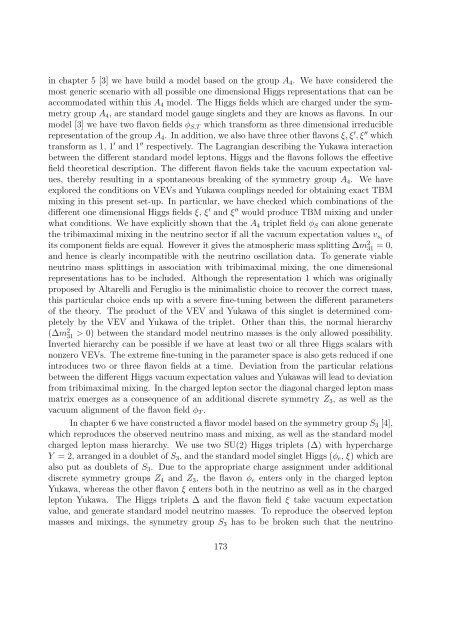PHYS08200604017 Manimala Mitra - Homi Bhabha National Institute
PHYS08200604017 Manimala Mitra - Homi Bhabha National Institute
PHYS08200604017 Manimala Mitra - Homi Bhabha National Institute
Create successful ePaper yourself
Turn your PDF publications into a flip-book with our unique Google optimized e-Paper software.
in chapter 5 [3] we have build a model based on the group A 4 . We have considered the<br />
most generic scenario with all possible one dimensional Higgs representations that can be<br />
accommodated within this A 4 model. The Higgs fields which are charged under the symmetry<br />
group A 4 , are standard model gauge singlets and they are knows as flavons. In our<br />
model [3] we have two flavon fields φ S,T which transform as three dimensional irreducible<br />
representation of the groupA 4 . In addition, we also have three other flavons ξ,ξ ′ ,ξ ′′ which<br />
transform as 1, 1 ′ and 1 ′′ respectively. The Lagrangian describing the Yukawa interaction<br />
between the different standard model leptons, Higgs and the flavons follows the effective<br />
field theoretical description. The different flavon fields take the vacuum expectation values,<br />
thereby resulting in a spontaneous breaking of the symmetry group A 4 . We have<br />
explored the conditions on VEVs and Yukawa couplings needed for obtaining exact TBM<br />
mixing in this present set-up. In particular, we have checked which combinations of the<br />
different one dimensional Higgs fields ξ, ξ ′ and ξ ′′ would produce TBM mixing and under<br />
what conditions. We have explicitly shown that the A 4 triplet field φ S can alone generate<br />
the tribimaximal mixing in the neutrino sector if all the vacuum expectation values v si of<br />
its component fields areequal. However it gives the atmospheric mass splitting ∆m 2 31 = 0,<br />
and hence is clearly incompatible with the neutrino oscillation data. To generate viable<br />
neutrino mass splittings in association with tribimaximal mixing, the one dimensional<br />
representations has to be included. Although the representation 1 which was originally<br />
proposed by Altarelli and Feruglio is the minimalistic choice to recover the correct mass,<br />
this particular choice ends up with a severe fine-tuning between the different parameters<br />
of the theory. The product of the VEV and Yukawa of this singlet is determined completely<br />
by the VEV and Yukawa of the triplet. Other than this, the normal hierarchy<br />
(∆m 2 31 > 0) between the standard model neutrino masses is the only allowed possibility.<br />
Inverted hierarchy can be possible if we have at least two or all three Higgs scalars with<br />
nonzero VEVs. The extreme fine-tuning in the parameter space is also gets reduced if one<br />
introduces two or three flavon fields at a time. Deviation from the particular relations<br />
between thedifferent Higgs vacuum expectation values andYukawas will lead to deviation<br />
from tribimaximal mixing. In the charged lepton sector the diagonal charged lepton mass<br />
matrix emerges as a consequence of an additional discrete symmetry Z 3 , as well as the<br />
vacuum alignment of the flavon field φ T .<br />
In chapter 6 we have constructed aflavor model based onthesymmetry groupS 3 [4],<br />
which reproduces the observed neutrino mass and mixing, as well as the standard model<br />
charged lepton mass hierarchy. We use two SU(2) Higgs triplets (∆) with hypercharge<br />
Y = 2, arrangedinadoublet of S 3 , andthe standardmodel singlet Higgs(φ e , ξ) which are<br />
also put as doublets of S 3 . Due to the appropriate charge assignment under additional<br />
discrete symmetry groups Z 4 and Z 3 , the flavon φ e enters only in the charged lepton<br />
Yukawa, whereas the other flavon ξ enters both in the neutrino as well as in the charged<br />
lepton Yukawa. The Higgs triplets ∆ and the flavon field ξ take vacuum expectation<br />
value, and generate standard model neutrino masses. To reproduce the observed lepton<br />
masses and mixings, the symmetry group S 3 has to be broken such that the neutrino<br />
173
















